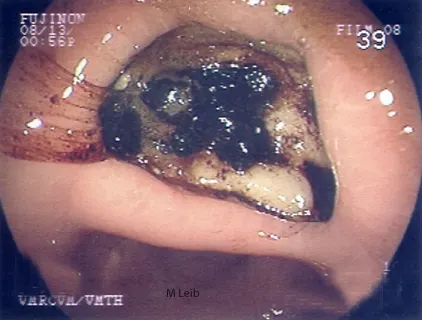Online Gallery: Normal and Abnormal Findings for Upper Endoscopy
Endoscopy of the upper GI organs allows visualization of the esophagus, stomach, and proximal duodenum. This procedure can assist in the diagnosis of foreign bodies, inflammation, inflammatory bowel disease, ulcers, tumors, and strictures of the upper GI tract. It is often performed to further evaluate patients with changes in appetite, weight loss, vomiting, diarrhea, intestinal bleeding, or unexplained anemia. Recognizing normal structures and patterns of abnormal tissue can simplify biopsy sampling.

Large gastric ulcer in a 10-year-old Rottweiler. Black clotted blood is adhered to the crater of the large ulcer. The horizontal ridge is the angularis incisura; the antrum is located below the angularis.
Related Article: Gastrointestinal Endoscopy in Dogs
Related Article: Physaloptera spp Infection in a Cat